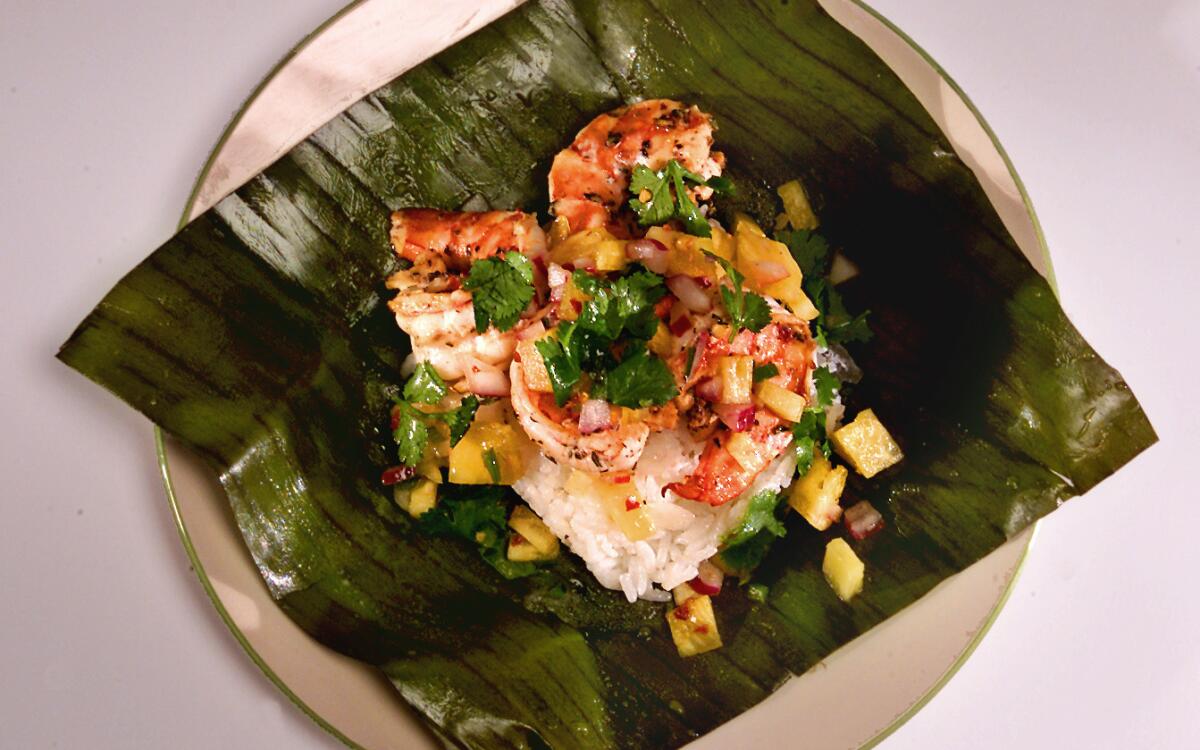Backyard Barbecue Shrimp Tamales With Pineapple Pico de Gallo

- Share via
I have to admit, the first time I ate tamales, I didn’t care for them much. The flavor was pretty good, but they had the consistency of dense, boiled dough. The way they were wrapped seemed a mystery. Why was there that flap of tamale that was never quite tucked inside the corn husk with the rest of it?
I came to realize that many other people also feel confused about tamales. To this day, I regularly see people attempting to eat the corn husk.
But every once in a while, you get one of those super tamales: a drop-dead, knockout, outrageously delicious epiphany of flavor and texture. The type of defining moment that drives one to shout out loud: “Boy, I want to have more of that!”
In New Mexico, where I grew up, those great homemade tamales had a short season. They’d pop up around the Christmas holidays, then--poof!--they were gone. Of course, ordinary tamales were always there. In mediocre restaurants, you could find them on the combination plate, buried between pasty refried beans and tepid, rose-colored rice.
Not being satisfied with great tamales only once a year, I became obsessed. I ordered them whenever I saw them on the menu. I searched them out at family gatherings and hovered around the kitchen table as the tias and abuelitas rolled, tucked, tied and folded the fragrant little packages. I chose my vacations to Mexico or Central America based on the anticipation of eating a particularly famous regional tamale.
In my restaurant, I started putting tamales on the menu. People seemed to appreciate that, so I branched out, offering more and more different kinds--some not at all traditional. In my last restaurant, in the early ‘90s, I installed a complete tamale bar that offered 30 different tamale flavors (including sweet dessert tamales) at any one time and another 70 flavors that could be ordered in advance.
I wasn’t alone, of course. Creative chefs all over the country were adding tamales to their menus. Traditional Latin restaurants were offering lighter, more healthful tamale choices. The Indio International Tamale Festival started. Zarela Martinez, from New York City, was shown on television serving tamales to world leaders at the dinner for the Williamsburg Summit of Industrialized Nations! Charity events featured celebrity chefs such as Wolfgang Puck, Patricia Quintana, Norman Van Aken and Nobu Matsuhisa serving cutting-edge international tamales. Even Martha Stewart has had a tamale cooking class on her show.
Specialty tamale restaurants and boutique takeout stores are opening offering all-tamale menus. Family tamaladas (tamale-making parties), though still popular, have morphed into trendy gourmet tamale potlucks. Grocery stores and neighborhood farmers markets now offer well-packaged, interesting tamales of all kinds.
Finally, tamales have fully arrived on the American table.
Marinated shrimp
Whisk together the lemon juice, oil, water, hot pepper sauce, cayenne, black pepper and rosemary in a bowl. Add the shrimp and toss to coat well. Cover the bowl with plastic wrap and marinate the shrimp in the refrigerator up to 2 hours.
Pineapple pico de gallo
Combine the pineapple, cilantro, red onion, jalapenos, lime juice, salt, white pepper, red pepper flakes and cumin. Mix well to combine. Set aside at room temperature or in the refrigerator.
Assembly
Place the rice in a colander and rinse it under cold running water until the water runs clear. Place the rice in a saucepan or rice cooker; add the water and salt; stir and cover. Bring the rice to a boil (alternatively, follow the rice cooker instructions, if using). Reduce the heat to a very slow simmer and cook the rice until tender, about 12 minutes. Let cool.
Heat the grill.
Lay out each banana leaf square on a flat work surface and brush each lightly with the olive oil. Divide the rice evenly among the leaves. Working with one leaf, mold the rice into a rectangular shape. Fold the two opposite sides of the leaf over, and then fold the other two sides to form a tight envelope package. Repeat for the remaining tamales.
Fill the bottom of a steamer or saucepan fitted with a strainer or vegetable basket with 2 to 3 inches of water. Bring the water to a boil and place the tamales in the steamer. Cover tightly with a lid or foil (it is important that no steam escapes while cooking). Steam the tamales for about 6 minutes over lightly boiling water, adding more water as needed. Remove the tamales from the steamer and set aside; do not unwrap.
Remove the shrimp from the marinade and grill them until they’re firm yet still juicy, about 3 minutes; do not overcook.
Transfer the tamales to serving plates. Unwrap one side of each of the tamales to expose the rice and place the shrimp over the rice. Place the Pico de Gallo on top of the shrimp.
Get our Cooking newsletter.
Your roundup of inspiring recipes and kitchen tricks.
You may occasionally receive promotional content from the Los Angeles Times.















